Green comet 2023 – live: How to see E3 in sky tonight before it disappears forever
A green comet is flying past Earth for the first time in 50,000 years, offering skygazers a one-off opportunity to witness the celestial spectacle before it disappears from our Solar System forever.
The C/2022 E3 (ZTF) comet made its closest approach to Earth on 1 February, 2023, but will continue to be visible throughout the week from anywhere in the northern hemisphere – weather permitting.
At a relatively close 42 million kilometres (26 million miles) from our planet, and with a brightness value of the magnitude of about +6, it will be possible to see it with the naked eye.
The comet is so rare that woolly mammoths and saber-toothed cats were still roaming the Earth when it last swept by our planet.
To find out where in the sky to look, and learn when conditions are best for viewing the comet tonight and over the next few days, you can follow our live coverage in the blog below.
Key Points
Nasa ‘expecting new discoveries’ from green comet
Where the best viewing conditions for the green comet are right now
How to see the green comet
Much more to see in February’s night sky
How to spot green comet if you missed it today
Thursday 2 February 2023 04:08 , Anthony Cuthbertson
The green comet is expected to slowly fade away from the skies over this week, but there will still be chances to get a glimpse of the cosmic entity over the following days.
The comet’s trajectory will take it past the bright star Capella on 5 February, before swinging by Mars on 10 February.
This graphic, made using Nasa and JPL-Caltech data, shows the path of the green comet as it passes through the solar system. (You can find an excellent indepth visual explainer on the comet right here.)
The Red Planet and the location of nearby stars and constellations might make it easier to spot.

With a full moon on 5 February, experts say the darker evening hours before moonrise in the coming days will be the best bet for spotting it in the sky.
Missed the comet? Don’t worry yet
11:00 , Andrew Griffin
The green comet hasn’t been past Earth for 50,000 years – and the experience of coming so close might mean that it never comes back again, as it will forever alter its orbit. 1 February was the important date, when it was closest to Earth and at its brightest.
However, if you missed it, don’t necessarily worry: next week might be the best time to see it after all. Around 10 February, the Moon will be less bright and the comet might actually be clearer, as it passes Mars.
You can find out more on that – and what else is going on in the night sky through the rest of the month – from Nigel Henbest, here.
What else is there to see this month?
Friday 3 February 2023 16:52 , Andrew Griffin
If the arrival of the green comet has got your eyes turned upwards, it’s not the only thing you’ll see. There are other planets that are unusually bright and visible – and much more besides.
You can find out all the goings on in here, Nigel Henbest’s rundown of what’s going on in February’s night sky.
The 2023 ‘green comet’ is now visible from Earth for the first time in 50,000 years
Friday 3 February 2023 10:30 , Josh Marcus
The first comet to light up the night sky since the Neowise comet in 2020 is approaching Earth.
The E3 comet – also known as C/2022 E3 (ZTF) – is not just a once-in-a-lifetime event, it is a once-in-an-epoch spectacle that was last seen when Neanderthals still roamed the Earth 50,000 years ago.
The green comet passed within 26 million miles of Earth on 1 February; it is already visible to people in the Northern Hemisphere with binoculars or telescopes under the right viewing conditions.
Anthony Cuthbertson reports.

The ‘green comet’ is now visible from Earth for the first time in 50,000 years
Watch as a green comet flies by Earth
Friday 3 February 2023 07:59 , Josh Marcus
Watch as a green comet flew past Earth for the first time in some 50,000 years before disappearing from our Solar System.
The C/2022 E3 (ZTF) comet is so rare that woolly mammoths and saber-toothed cats were still roaming the Earth when it last swept by.
It was visible as it made its closest approach to Earth in the early hours of 1 February, 42 million kilometres away, and was seen again tonight.
While previous sightings have been through binoculars and telescopes, it’s expected to look so bright on Wednesday and Thursday that you could be able to see it with the naked eye.
More details in our full story.

Watch as a green comet flies by Earth
How to track green comet over the week
Friday 3 February 2023 07:29 , Vishwam Sankaran
Greenwich Royal Observatory says the green comet in its current close approach to Earth is near the constellation of Camelopardalis.
Then after its close approach, it will move through Auriga and end up in Taurus mid-February, the observatory noted.
On 10 February, the comet can be seen next to Mars after February’s full moon.
“The comet will dim over the month as it moves away from us, and the time that it will be up in the sky during the night will get shorter and shorter,” the Greenwich Royal Observatory said.
What studying comets has revealed in past
Friday 3 February 2023 07:02 , Vishwam Sankaran
Astronomers study comets to understand their composition which can then yield insights on the conditions under which they formed.
Studying comets like ZTF, which are long-period comets have orbital periods longer than 200 years, can unravel mysteries about the origins of the Solar System.
Their chemical composition can also reveal secrets about how different molecules behave in the vastness of space under the influence of radiation from the Sun and other sources.
For instance, one such study 70 years ago, which assessed data on the motion of comet tails revealed the presence of the solar wind.
Not only does the chemical composition of comets reveal a great deal about the formation of our #SolarSystem and origins water on Earth, but just 70 years ago the motion of their tails revealed the presence of the solar wind.
📸#Rosetta’s comet pic.twitter.com/gNFozqti0O— ESA Operations (@esaoperations) February 1, 2023
Until then the space between planets in the Solar System was thought to be almost empty.
But solar physicist Eugene Parker, inspired by research on comet tails, came up with the idea that constant wind emanates from the Sun.
Green comet 'failed to wow' astronomers observing in X-ray light
Friday 3 February 2023 06:28 , Vishwam Sankaran
The European Space Agency tweeted that the green comet, that has not passed by Earth since Neanderthals roamed, has “failed to wow” those observing it in X-ray light.
ESA scientists attempted to study the comet using data from the XMM-Newton X-ray satellite, which has been in orbit since 1999, but said the comet barely showed up in the X-rays.
Today, #CometZTF makes its Earth close approach!
Billions of years old, not seen since Neanderthals roamed, the green comet has grown an apparent third tail & unexpectedly (intriguingly) failed to wow observed in x-ray light.
More🧵👇☄️👉https://t.co/oDpx0tlSep
©️Oscar Martín pic.twitter.com/y2mZLRv2Pd— ESA Operations (@esaoperations) February 1, 2023
The results, however, are “scientifically very valuable,” the space organisation tweeted.
ICYMI: Green comet's discovery explained
Friday 3 February 2023 05:59 , Vishwam Sankaran
The green comet, formally known as C/2022 E3 (ZTF), was discovered by astronomers from the Zwicky Transient Facility in March 2022.
Using the facility’s robotic camera and machine learning tools, astronomers first detected a moving object in a twilight survey while scouring through hundreds of images.
They initially thought it was an asteroid, but the space rock’s condensed coma and its projected path indicated it was a comet.
“On March 2nd, all we knew was that we had found a moving object. We reported it to the Minor Planet Center – they are the clearing house for these things,” Tom Prince, one of the lead scientists on the project, told The New Yorker.
“This particular object was spotted because of its motion in a sequence of images taken by ZTF,” Dr Prince said.
The comet, now at its closest distance to Earth, is predicted to disappear into the darkness of space, likely never to be seen by humans again.
ICYMI: How scientists solved mystery behind green shade of some comets
Friday 3 February 2023 05:30 , Vishwam Sankaran
Several comets in history have been observed to glow with a greenish hue as they zoom past the Earth’s sky. However it had remained a mystery for decades why the green colour glow never reached these comets’ tails.
Although it had long been theorised that diatomic carbon (C2), created by the interaction of the comet dust with sunlight’s UV radiation may have been behind the glow, this hadn’t been tested till 2021 since the dicarbon molecule is very unstable.
Chemistry professor Timothy Schmidt from the University of New South Wales in Australia demonstrated in 2021 the process by which the dicarbon molecule is broken up by sunlight.
“The green colour comes from C2, which is itself a breakdown product of larger molecules in the snowball. The C2 breaks down into C atoms in a few days. The green is due to C2 absorbing and emitting light in a process known as fluorescence,” Dr Schmidt explained in a recent tweet.
What does the ‘exotic’ green comet look like in the night sky?
Friday 3 February 2023 05:00 , Josh Marcus
The world is being visited by a guest who has not come by in 50,000 years.
The greenish comet has been hurtling towards Earth for months, but this week will be the most visible to anyone who wants to see it as it makes its closest pass by Earth.
At 26.4 million miles away, it should be close enough to see. What’s more, it will hang around, allowing people to see it through this week and on.
Andrew Grffin has the details.

What to expect as ‘green comet’ hurtles towards close encounter with Earth
ICYMI: Green comet to leave solar system, may never fly past Earth again
Friday 3 February 2023 04:32 , Vishwam Sankaran
Scientists tracking the orbit path of the green comet say it may not return to the inner Solar System again.
They say the comet’s orbit shape looks like an open curve.
The comet may “soon escape the Solar System entirely” due to its orbit, according to Franck Marchis from the SETI Institute.
“This is probably the last time this comet will ever be visible to us, or to anyone living on Earth....But maybe in a distant future, another intelligent species will see it coming close to their sun and their own home planet,” Dr Marchis tweeted.
Green comet photographed above Stonehenge
Friday 3 February 2023 04:06 , Vishwam Sankaran
The comet ZTF that previously passed by Earth during the Stone Age was photographed for the first time over Stonehenge.
ZTF last hurtled past the planet about 50,000 years ago long before early humans built the stone circle.
A comet last visible during the Stone Age has appeared for the first time over Stonehenge.
The last time the green comet, called C/2022 E3 (ZTF), was visible from Earth was around 50,000 years ago, long before the stone circle was built.
📷: @Josh_Dury pic.twitter.com/EifKIOLThZ— Stonehenge (@EH_Stonehenge) February 2, 2023
It is currently at it closest position relative to the Earth, zooming past the Earth at about 57km/s at a distance of just 26 million miles.
Astronomers say the object would look like a “fuzzy green ball” or a “smudge” in the night sky.
Andrew Griffin reports

What does the ‘exotic’ green comet look like in the night sky?
ICYMI: How green comet's brightness compares to others in history
Friday 3 February 2023 03:46 , Vishwam Sankaran
The comet ZTF’s brightness is estimated to be about a magnitude of about +6 which could make it almost visible to the naked eye.
Astronomers measure the brightness of objects in the sky using a scale of apparent magnitude in which brighter objects have greater negative number and dimmer ones have greater positive values.
The latest reported observed magnitude for Comet C/2022 E3 (ZTF) is 5.9. Naked eye visibility from a dark site.
— David Blanchflower BSc (@DavidBflower) January 20, 2023
The brightest planet Venus, for instance, has a magnitude of around -3 to -4, and the Sun has a magnitude of –26.
The famous Halley’s comet had a magnitude of about +2 during its 1986 passby, and the comet Bennett, discovered in 1969 had a +8.5 magnitude.
ICYMI: What does the ‘exotic’ green comet look like in the night sky?
Friday 3 February 2023 01:30 , Josh Marcus
For the first time in 50,000 years, a stunning green comet has skipped past Earth, making a remarkably close approach.
The flyby was close enough to be visible to the naked eye, and bright enough to be captured in stunning images taken from the Earth.
For those who saw it, the green comet looked like a flaming verdant star, hovering in the sky. But for many others, the comet might not have been visible at all: without the right conditions and work, it might not be visible at all.
Don Pollacco, a professor from the department of physics at the University of Warwick, said that anyone looking to see it would need “a clear sky, binoculars and a bit of luck”. The waxing Moon means that the comet could be hard to spot.
Andrew Griffin reports.
Green comet glows in London sky
Thursday 2 February 2023 23:34 , Graeme Massie
Footage captured on Monday night from west London shows the green comet is visible from the UK capital despite the light pollution.
Twitter user @spacestationguy said he used a 10-inch dobsonian scope and Sony A7S camera to get the shot of Comet C/2022 E3 (ZTF). Weather over the UK means no spottings were possible last night, and may also be hampered by cloud cover tonight too.
You can see the video from Monday here:
Watch a live stream of the green comet from last night
Thursday 2 February 2023 22:58 , Graeme Massie
The Virtual Telescope Project and Telescope Live used their telescopes in Italy and Spain to capture Comet C/2022 E3 in real-time last night.
They shared a stream of it on their YouTube channel, allowing anyone in the world to watch it for free.
You can watch the live stream here:
Nasa shares December image of green comet
Thursday 2 February 2023 22:25 , Graeme Massie
Nasa’s Goddard flight centre has shared an image of the green comet, taken all the way back in December.
The US space agency tweeted the image to mark the day that Comet C/2022 E3 (ZTF) is at its closest point to Earth, known as its perigee.
“This comet was discovered in March 2022 by Bryce Bolin, a NASA postdoctoral fellow at Goddard and Frank Masci, a senior scientist at Caltech,” Nasa notes. “They used the wide-field survey camera at the Zwicky Transient Facility.”
A green comet will be closer to our planet today, Feb 2, than it's been in over 50,000 years! The brightness of comets is unpredictable, but with clear skies, you could see Comet C/2022 E3 (ZTF)!https://t.co/Isqg1V1LZG pic.twitter.com/bwdFZXpTK8
— NASA Goddard (@NASAGoddard) February 2, 2023
Although the comet is now heading away from us, it is still visible to anyone in the northern hemisphere, so long as the weather conditions are favourable.
Where you can see the green comet in UK and US
Thursday 2 February 2023 19:38 , Anthony Cuthbertson
Weather forecasts for central and southern United States suggest ideal viewing conditions for the green comet, with clear skies stretching all the way from Chicago to El Paso.
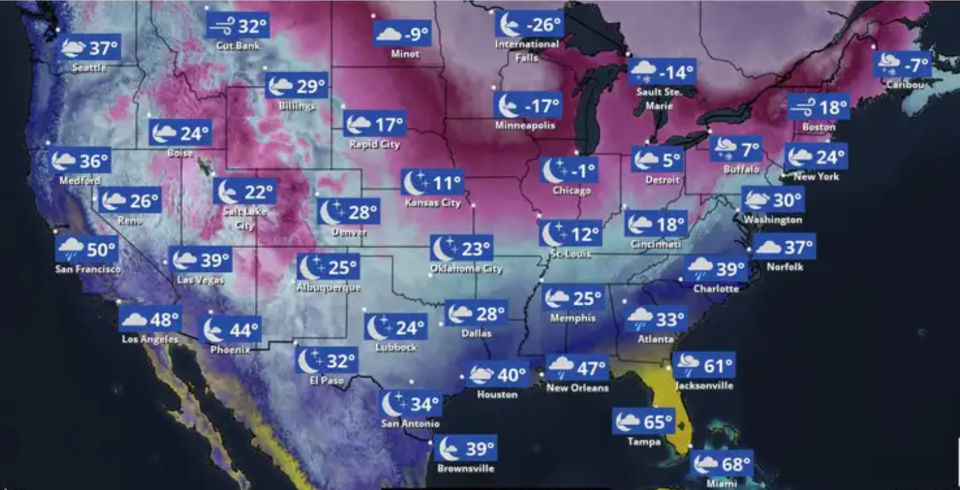
Weather in the rest of the country is not great for seeing the comet, although it’s nowhere near as bad as the UK.
Unfortunately for people in the UK and Ireland, there is near-total cloud cover tonight, according to the Met Office. Anyone hoping to see Comet C/2022 E3 (ZTF) will have to wait until Saturday night to catch a glimpse of it.

Green comet images show progress across sky over a fortnight
Thursday 2 February 2023 15:45 , Anthony Cuthbertson
We have more photos of the green comet, this time from Imran Sultan, an astrophysics student at the Center for Interdisciplinary Exploration and Research in Astrophysics at Northwestern University.
The images were taken between 19 January and 1 February, 2023.
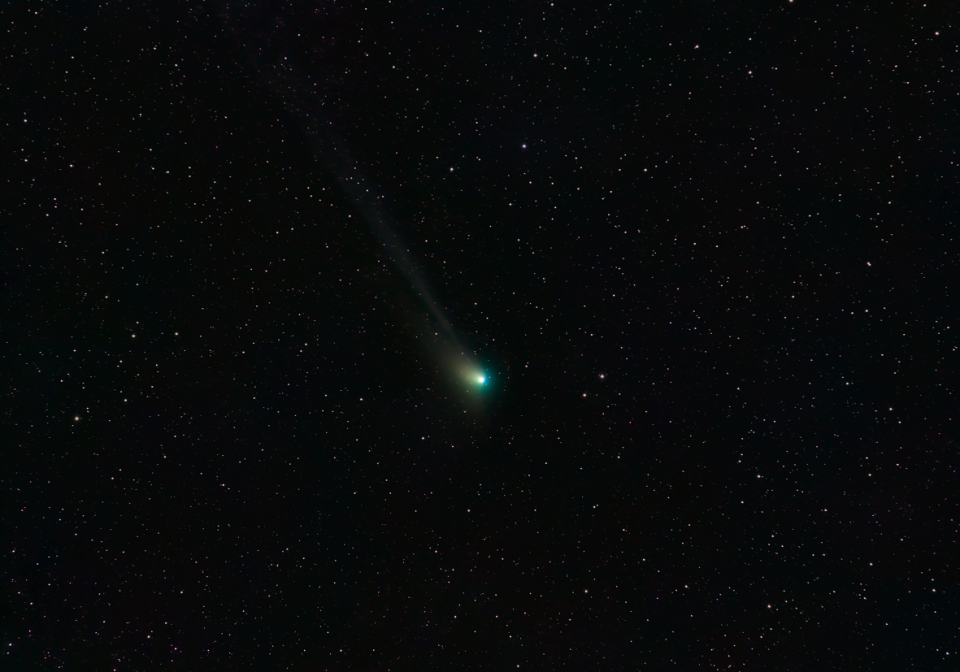
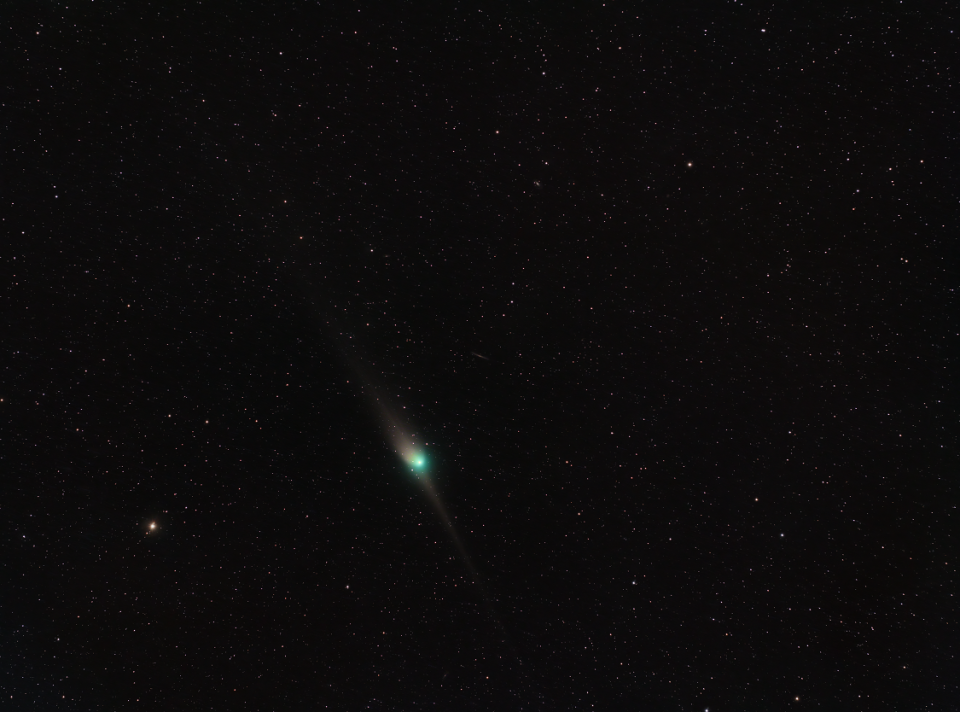
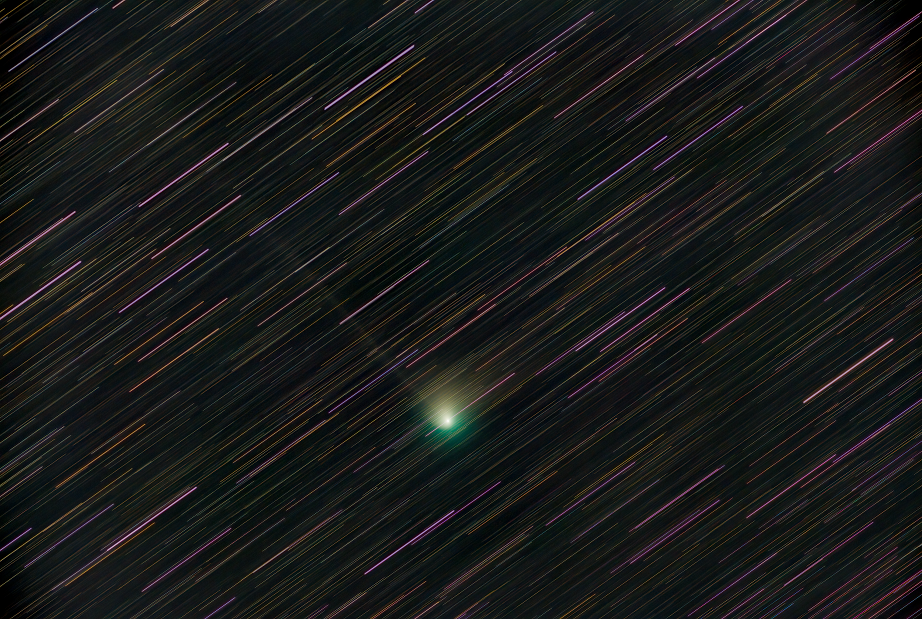
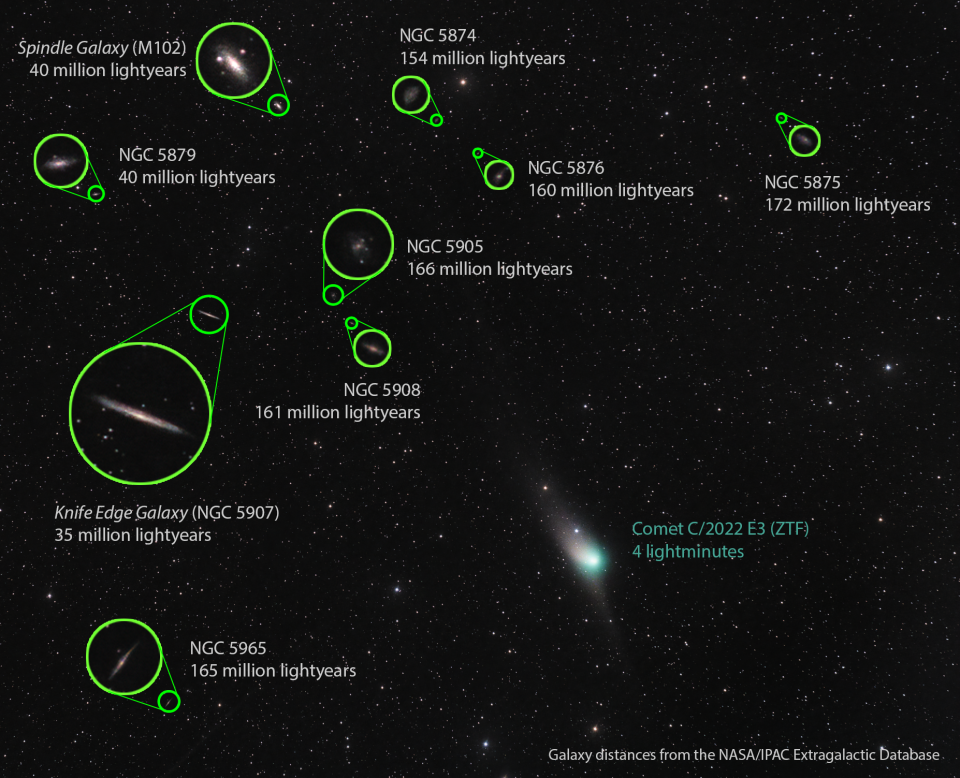
Digital telescopes capture stunning images of green comet
Thursday 2 February 2023 14:49 , Anthony Cuthbertson
We’ve received some great photos of the green comet taken by amateur astronomers.
The four below were taken by Nelson Decker, Scott Kardel, Jeffrey D’Elia and Didier Cowen, who were all using Unistellar telescopes.
The digital telescopes are described by Unistellar as “nearly foolproof” for even novice skywatchers, allowing them to track and capture objects in the sky through a companion app.


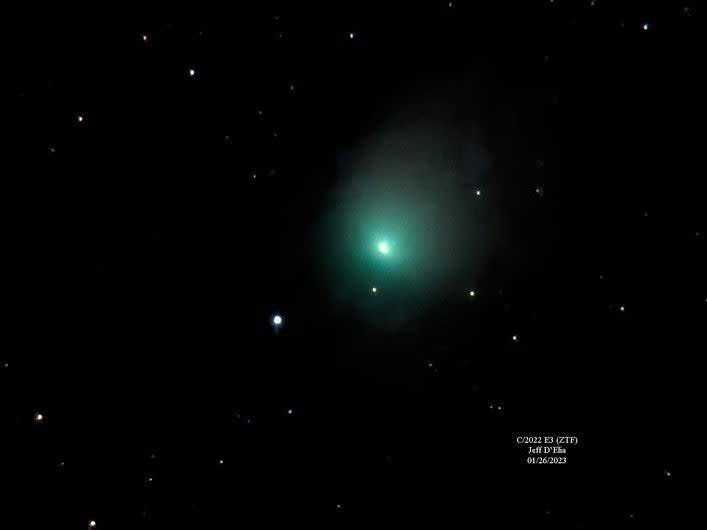

Green comet that will be visible from Earth for first time since ice age is undergoing unusual changes
Friday 3 February 2023 01:33 , Josh Marcus
A green comet that will be visible from Earth for the first time since the Ice Age appears to be undergoing unusual changes.
Comet ZTF has created excitement in recent weeks as it has hurtled towards Earth, coming close enough to the planet that it should be visible to the naked eye. It will be the first close approach for 50,000 years, and reached its closest point on 1 February.
New pictures of the object appear to show that its tail has become detached. Images taken by comet hunter Michael Jäger, for instance, make it look as if the tail is breaking off.
Andrew Griffin reports.

‘Something unusual’ is happening to a rare green comet that is coming towards Earth
Best night for viewing green comet in the UK
Thursday 2 February 2023 11:07 , Anthony Cuthbertson
Unfortunately for UK sky gazers, the cloud cover that blocked the green comet last night is set to continue this evening.
The latest forecasts from the Met Office show the whole of the UK and Ireland covered in cloud on Thursday and Friday evening.
The good news is the cloud will almost comletely clear on Saturday night, offering great views of Comet C/2022 E3 (ZTF) in the early hours of Sunday morning.
Here is the current forecast for midnight tonight:

And this is the forecast for 4am on Sunday morning:

Space photographer captures stunning images of green comet
Thursday 2 February 2023 09:51 , Anthony Cuthbertson
Space photographer Miguel Claro has captured several stunning images of the green comet from the Dark Sky Alqueva Observatory in Portugal.
The astrophotographer has even made a video of Comet C/2022 E3 (ZTF)’s progress across the night’s sky.
The SETI Institute notes that “something unusual” is happening with the comet’s green and blue tail, as the long ion trail experiences something known as a disconnection event.
The images and footage has been shared on social media, which you can see below.
#PPOD: A close-up view of #CometZTF during 19th January 2023. Besides featuring a wonderful greenish coma and rare anti-tail, something unusual was happening with the long ion tail, what is called a disconnection event. Credit: © Miguel Claro | https://t.co/92arqPX425 pic.twitter.com/03k5po4r21
— The SETI Institute (@SETIInstitute) January 24, 2023
Last week, a CME hit #CometZTF (C/2022 E3) and broke the comet's tail.
Astrophotographer Miguel Claro made a video of the event from the Dark Sky® Alqueva Observatory in Portugal.
Comet ZTF is approaching Earth for a close encounter (0.28 AU) on Feb. 1st. pic.twitter.com/67ycrJawFv— Girl In Space (@ExploreCosmos_) January 27, 2023
Green comet spotted over Greece
Thursday 2 February 2023 07:54 , Graeme Massie
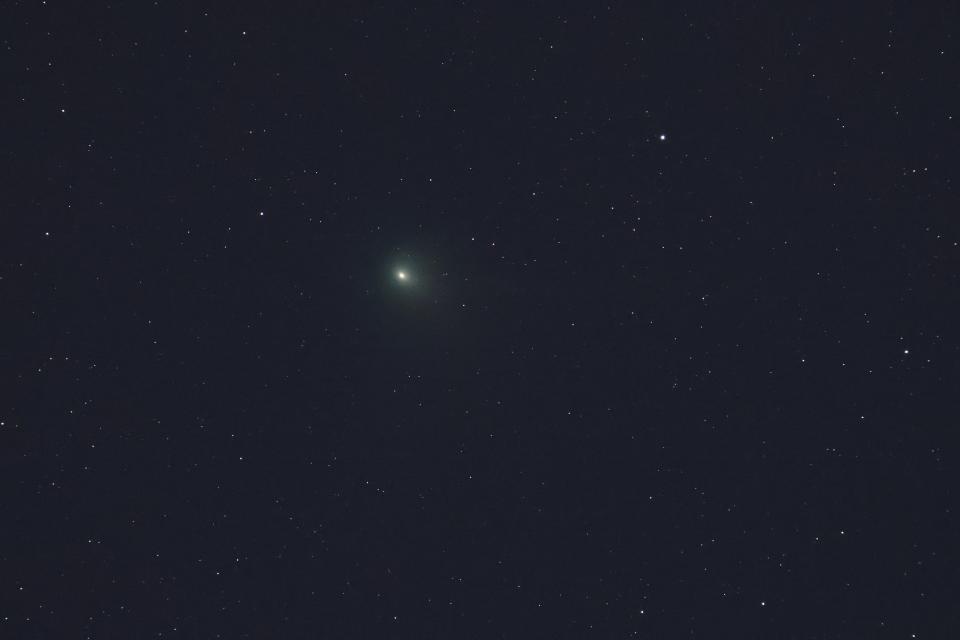
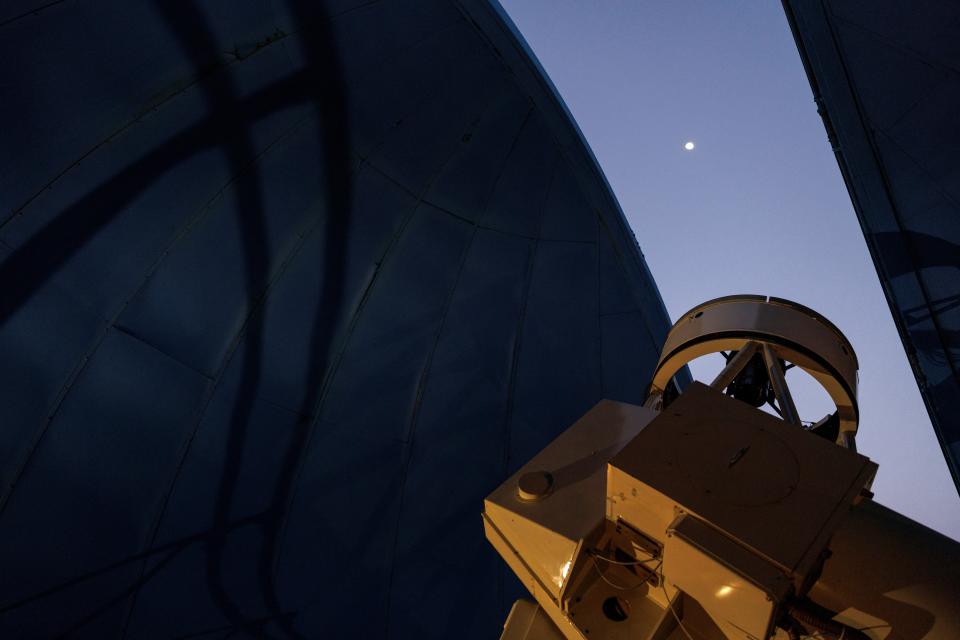

How bright was green comet compared to others in history
Thursday 2 February 2023 07:25 , Vishwam Sankaran
The green comet ZTF is currently at its closest position relative to the Earth, zooming past the planet at about 57km/s at a distance of merely 26 million miles.
Its brightness has been estimated to be at a magnitude of about +6 – almost the threshold of what can be visible to the naked eye – and is also expected to be the brightest such space rock to zoom past Earth this year.
The brightness of objects in the sky is measured on a scale of apparent magnitude by astronomers.
The brighter an object, the greater its negative number and the dimmer it is, the greater will be the positive number.
For instance, the sun has –26 magnitude compared with the full moon whose magnitude is around –13 magnitude to the naked eye.
The brightest planet in the sky – Venus – is estimated to have a magnitude of about -3 to -4, and large comets that achieve a similar brightness are unofficially called great comets.
The comet Bennett, discovered by amateur astronomer John Caister Bennett in 1969, was a magnitude 8.5 object.
The 1986 visit by the famous Halley’s comet had a magnitude of about +2 while its next pass expected in July 2061 is estimated to likely have a fairly spectacular brightness of about –0.3.
The comet Bennett, discovered in 1969 by South African amateur astronomer John Caister Bennett, was a magnitude 8.5 object when it was first identified.
Some of the faintest stars visible to the unaided eye have magnitudes of about 6.5.
Spectacular images shared of the ‘exotic’ green comet
Thursday 2 February 2023 07:01 , Graeme Massie
If you’re yet to catch a glimpse of the green comet, we’ve got a round-up of images captured by professional and amateur astronomers in recent days.
One picture, from the New Scientist’s Abby Beall, was notable not for its spectacular nature but for its help in seeing the comet. As she noted, the comet might not actually be easily visible – but spotting it might be possible using a phone, as well as the helpful map that she assembled.

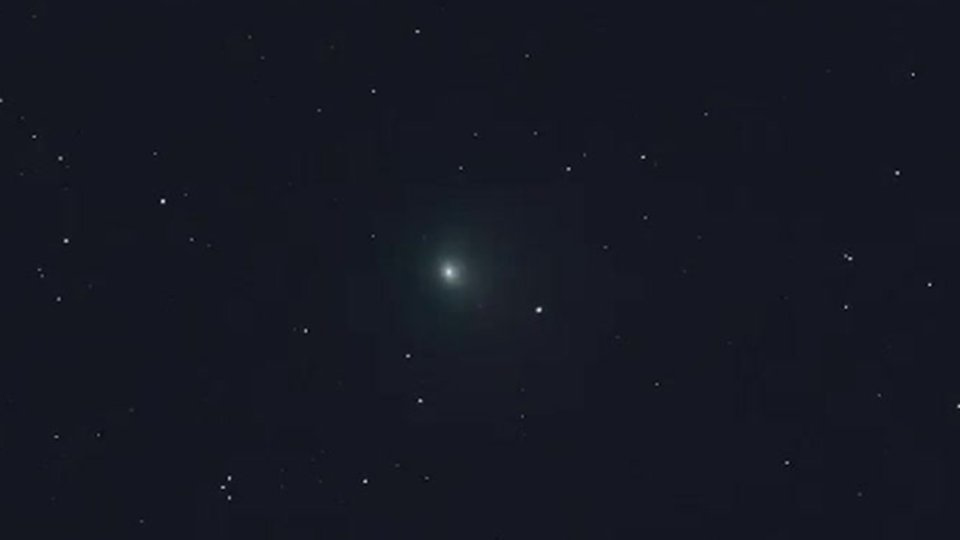
You can see all of the pictures here:

What does the ‘exotic’ green comet look like in the night sky?
ICYMI: How green comet was first discovered
Thursday 2 February 2023 06:40 , Vishwam Sankaran
The green comet C/2022 E3 (ZTF) was found in March 2022 by astronomers from the Zwicky Transient Facility.
Researchers used ZTF’s robotic camera and software developed by staff scientist Frank Masci to detect a moving object.
It was initially thought to be an asteroid, but the space rock’s condensed coma and its trajectory indicated it was a comet.
“This particular object was spotted because of its motion in a sequence of images taken by ZTF,” said Tom Prince, professor of physics from the Keck Institute for Space Studies.
“At the time it was discovered, it was not known to be a comet. That came later after follow-up observations by many telescopes worldwide,” Dr Prince said.
The comet has come closest to Earth today at about 41 million km (26 million miles) away, and after that, it is expected to disappear into the darkness of space, likely never to be seen by humans again.
ICYMI: Green comet may never fly past Earth again
Thursday 2 February 2023 06:18 , Vishwam Sankaran
Scientists studying the green comet’s orbit trajectory say it is in an open “hyperbolic orbit,” meaning it may not return to the inner Solar System again.
Robert Massey, deputy executive director of the UK Royal Astronomical Society, told Newsweek that the comet’s orbit shape looks like a “very open curve.”
Astronomers, including Franck Marchis from the SETI Institute, also say the comet may “soon escape the Solar System entirely” due to its orbit.
Comet C/2022 E3 ZTF observed by @palomarskies and a SETI perspective. #cometE3 #SETI @setiinstitute pic.twitter.com/TKuMlrVrRW
— Franck Marchis (@AllPlanets) January 28, 2023
“This is probably the last time this comet will ever be visible to us, or to anyone living on Earth....But maybe in a distant future, another intelligent species will see it coming close to their sun and their own home planet,” Dr Marchis tweeted.
“In that sense, this comet is carrying a piece of us – of all humanity – into the cosmos,” he said.
Watch the green comet’s orbital path
Thursday 2 February 2023 06:05 , Graeme Massie
The green comet is currently making its closest path of Earth in 50,000 years. This graphic, made using Nasa and JPL-Caltech data, shows the path of the green comet as it passes through the solar system.
You can find an excellent indepth visual explainer on the comet right here.
ICYMI: What comet's green colour reveals about its chemical composition
Thursday 2 February 2023 05:52 , Vishwam Sankaran
Based on the green colour of the comet ZTF, astronomers say it contains molecules like diatomic carbon and cyanogen.
Diatomic carbon (C2) is a green, gaseous chemical with the formula C=C and is known to occur in the carbon vapour in comets.
While many comets glow green as they zoom past the Earth’s sky, it had for long remained a mystery why this hue never reached their tails.
Scientists as early as the 1930s had theorised that diatomic carbon that was created by the interaction of sunlight’s UV radiation and organic matter on the comet’s head was being further destroyed leading to the colour.
But the theory hadn’t been tested until late 2021 as diatomic carbon is not stable.
To be clear @abcnews, the green colour comes from C2, which is itself a breakdown product of larger molecules in the snowball. The C2 breaks down into C atoms in a few days. The green is due to C2 absorbing and emitting light in a process known as fluorescence.
— Prof. Timothy Schmidt (@schmidtim) January 29, 2023
Timothy Schmidt, a chemistry professor at the University of New South Wales, demonstrated in 2021 the mechanism by which the dicarbon molecule is broken up by sunlight.
“The green colour comes from C2, which is itself a breakdown product of larger molecules in the snowball. The C2 breaks down into C atoms in a few days. The green is due to C2 absorbing and emitting light in a process known as fluorescence,” Dr Schmidt explained in a tweet on Tuesday.
What comet studies have revealed about early Solar System
Thursday 2 February 2023 05:16 , Vishwam Sankaran
Studying the chemical composition of comets like ZTF have unravelled several secrets about the formation of the Solar System.
ZTF belongs to a category called long-period comets that are known to emerge from a shell of space debris in the outermost stretches of the Solar System called the Oort cloud.
The Oort cloud hasn’t actually been viewed by astronomers, but is theorised to be a vast, spherical shell made of icy debris, some of which may be as old as the Solar System itself.
A recent study, surveying gases like carbon monoxide and water vapour in 25 comets, suggested that analysis of these molecules from comets could trace the chemical composition of the early Solar System.
#GreenComet ☄️
Tomorrow it will be at its closest to Earth! Let us know if you see it. 🔭
📌A new study of comets provides insight into chemical composition of early solar system: https://t.co/wgPp0HhRku https://t.co/eym6O0sM3A— National Science Foundation (@NSF) February 1, 2023
Scientists could unravel insights about early solar systems based on the ratio of certain molecules present after outgassing from comets.
The research found, for instance, that comets very far from the sun that have never, or only rarely, orbited near the sun, produced more CO2 than CO, whereas those that have made many several trips close to the sun do the opposite.
Timelapse shows green comet pass over night sky
Thursday 2 February 2023 05:03 , Graeme Massie
Seeing the green comet can be tricky, even when you know where to look and the weather is good.
Capturing it for a timelapse video, however, is almost impossible. It requires no light pollution, clear skies and a specialist setup like this one. But the results are spectacular:
If you haven’t or can’t see the Green Comet, this guys got it for you pic.twitter.com/b6ECDoBZoq
— Slater Jonathan (@SlaterJonathan4) January 24, 2023
Next best viewing date for green comet
Thursday 2 February 2023 04:49 , Vishwam Sankaran
Although the green comet is making its closest approach to the Earth today, it may not be easy to view for many due to a bright moon and cloudy skies.
However, on 10 February, the comet would sweep next to Mars and this will also be after February’s full moon.
Comet C/2022 E3 (ZTF) aka "The Green Comet" is making its closest approach to the Earth today.
The moon is bright tonight, making it difficult to find the comet with the naked eye. On Feb 10th, the comet will be slightly above Mars, as seen in this star chart from EarthSky. pic.twitter.com/Ae73UgzlNe— CFHT (@CFHTelescope) February 1, 2023
“The moon is bright tonight, making it difficult to find the comet with the naked eye. On Feb 10th, the comet will be slightly above Mars, as seen in this star chart from EarthSky,” The Canada–France–Hawaii Telescope (CFHT) joint facility tweeted.
Strange phenomenon on green comet's tail explained
Thursday 2 February 2023 04:02 , Vishwam Sankaran
Usually, comets have two tails – one that is made of ionised gas and another of dust.
The ion tail can be spotted as the small molecules on its side glow via fluorescence.
In the dust tail, large grains scatter the Sun’s UV light in all directions.
These two tails point in slightly different directions as the forces act on dust and ions in different ways.
“Recently, a strange phenomenon has occurred with #CometZTF as it appears to have a third tail. This is, in fact, an optical illusion, due to our point of view of the dust trail” explains Jorge Amaya from ESA’s #SpaceWeather Office.
— ESA Operations (@esaoperations) February 1, 2023
But astronomers across the world reported a “third tail” on the green comet ZTF, which has been found to be just an “optical illusion.”
“Recently, a strange phenomenon has occurred with comet ZTF as it appears to have a third tail. This is, in fact, an optical illusion, due to our point of view of the dust trail,” European Space Agency’s Jorge Amaya explained.
Meteorologist on how best to view green comet
Thursday 2 February 2023 03:50 , Vishwam Sankaran
There are few more days left when one can view the green comet zoom past Earth, says Milwaukee meteorologist Mark Baden.
The comet ZTF will still be visible in the days leading to 10 February, appearing in the night sky as a faint green smudge.
Do you want to try to see the "Green Comet"? You have a few more days. Look for the North Star. It will be to the right of it. You will need binoculars to see it. pic.twitter.com/QmhVk4bgDT
— Mark Baden (@Mark_Baden) February 1, 2023
If the weather is favourable and clear with fewer clouds, one may see the comet in the night sky right of the north star.
People may still need binoculars or a telescope to view the comet.
Palaeontologist on what humans were like last time ZTF zoomed past Earth
Thursday 2 February 2023 03:38 , Vishwam Sankaran
The last time the green comet ZTF hurtled past Earth, Neanderthals may have seen its green tail “if they looked up from their cookfires,” says paleoecologist Jacquelyn Gill from the University of Maine in the US.
Dr Gill, who specialises in research on how the planet has changed since the last ice age, says modern humans – Homo sapiens – were just entering Europe when ZTF zoomed past Earth previously about 50,000 years ago.
Neanderthals would have seen its green tail overhead if they looked up from their cookfires. Modern humans, who were just entering Europe, were poised to flourish in an explosion of advanced culture—leaving traces of complex art, tools, music, body decoration, and ritual.
— Dr. Jacquelyn Gill (@JacquelynGill) February 2, 2023
“Some of the oldest cave paintings in the world, in Spain and Indonesia, date to this time,” she tweeted.
The human family tree during this time still had several more branches.
In addition to Homo sapiens, Dr Gill says, we had “Neanderthals, Denisovans, Floresians, maybe even others” when ZTF last flew past Earth.
ESA attempts to study green comet using X-ray satellite
Thursday 2 February 2023 03:16 , Vishwam Sankaran
The European Space Agency tweeted that it has been studying the green comet ZTF using its X-ray satellite XMM Newton in orbit since 1999.
Researchers had expected ZTF to be one of the brightest comets observed because of its bright green hue.
ESA missions inc. @ESA_XMM have been observing #CometZTF, and it was expected to be one of the brightest comets observed due to its bright green hue.
Disappointingly, then intriguingly, the comet barely showed up in the X-rays.
The results are scientifically very valuable. pic.twitter.com/44vwSrgYpp— ESA Operations (@esaoperations) February 1, 2023
However, “disappointingly” the comet “barely showed up in the X-ray,” ESA said.
But the space agency noted that the observations and results are still “scientifically very valuable.”
Where best to see the green comet in the US
Thursday 2 February 2023 03:02 , Graeme Massie
With the UK and Ireland completely covered in cloud tonight, at least people in the US will have a better chance of seeing the green comet.
Severe winter storms will make it impossible for people in the South to see for the next few days, but a bit further west will see ideal conditions. Forecasts from The Weather Channel show that the best views will be from the South West and Pacific Coast regions of the United States.
Tonight will see clear skies all the way from Los Angeles in California to Denver in Colorado.
Here’s the full forecast for tonight:

Tips for seeing green comet
Thursday 2 February 2023 02:01 , Graeme Massie
Mike Narlock, the head astronomer at Cranbrook Institute of Science in Bloomfield Hills, Michigan, told The Dearborn Press & Guide about the best way to spot the green comet.
– Go outside after dark.
– Look for the Little Dipper constellation. This will help you locate the North Star, also known as Polaris, at the end of the handle.
– Above the North Star, you will find the constellation Camelopardalis, commonly called the giraffe. The green comet is visible inside that constellation.
– If you must look for the comet without any devices, try using peripheral vision.
Live stream of green comet to be hosted by The Virtual Telescope Project
Thursday 2 February 2023 01:01 , Graeme Massie
The UK and Ireland are almost completely covered by cloud this evening, while large parts of the US will also find it difficult to see the green comet as winter storms sweep across the southeast.
Fortunately for those unable to witness Comet C/2022 E3 ZTF in the night sky, the Virtual Telescope Project will be hosting a live stream as it passes overhead. The project, setup by the Bellatrix Astronomical Observatory in Italy, consists of several robotic telescopes around the world that offer free views of the universe that are available for all to watch.
You’ll be able to find the live stream here when the broadcast begins in a few hours.
What impacts how bright a comet is?
Thursday 2 February 2023 00:01 , Graeme Massie
According to Nasa, “how bright a comet appears depends both on what we can predict, how close it is to the Earth and how close it is to the Sun, and on what we cannot predict, how much gas and dust it is giving off.”

How green comet appeared over California
Wednesday 1 February 2023 23:32 , Graeme Massie


Where to look to see the green comet this week
Wednesday 1 February 2023 23:04 , Graeme Massie
Wednesday night will be the worst night all week for people in the UK and Ireland to see the green comet, with the British Isles completely covered in clouds. However, the coming days will see the skies clear a bit, with forecasts from the Met Office suggesting that Friday will perhaps offer the best chance for many.
Here’s where to look in the night’s sky over the coming days:
Wednesday, 1 February: Look towards the constellation Camelopardalis
Thursday, 2 February - Saturday, 4 February: Between the constellations Camelopardalis and Auriga
Sunday, 5 February: The green comet will be near the star Capella in the constellation Auriga, however the full Moon may obstruct the view
Details on the green comet
Wednesday 1 February 2023 22:27 , Graeme Massie
Green comet seen from the island of Gran Canaria,
Wednesday 1 February 2023 21:31 , Graeme Massie

Timelapse shows green comet moving across the sky
Wednesday 1 February 2023 15:09 , Anthony Cuthbertson
This is one of the best timelapses of the green comet I’ve seen so far. It perfectly illustrates how it moves across the night’s sky.
Captured by astrophotographe Matt Graves, you can see just how far it travels in less than an hour. Hopefully we’ll be getting more like this from some of the big observatories in the coming hours and days.
You can watch it here:
The green comet I captured last night. This is about 45 min pic.twitter.com/jzAqHucB7W
— Matt Graves (@GravesSpectrum) January 29, 2023
Share your photos of the green comet
Wednesday 1 February 2023 13:47 , Anthony Cuthbertson
If you have any photos of the green comet, you can email me (anthony.cuthbertson@independent.co.uk) or share them with me at @ADCuthbertson on Twitter (my DMs are open) and I’ll post them here.
Green comet sightings hampered by cloud on Wednesday night
Wednesday 1 February 2023 11:39 , Anthony Cuthbertson
Weather forecasts from the Met Office suggest that viewing conditions for the green comet tonight in the UK and Ireland will be terrible.
Shortly after sunset, clouds rolling in from the Atlantic will nearly completely cover the British Isles, leaving only a sliver of clear skies in eastern Scotland. Even that won’t last for long, with the early morning of hours on Thursday seeing rain and cloud over all of England, Scotland, Wales, Northern Ireland and Ireland.
Here’s how the sky will look at 4am on the morning of Thursday, 2 February, according to the latest weather forecasts:

Watch the green comet drift across US sky
Wednesday 1 February 2023 10:10 , Anthony Cuthbertson
Footage posted to Twitter by Christopher Becke in Williamsburg shows the green comet in the sky above Virginia.
The amateur astronomer said the comet’s movement was captured by taking a series of 60 second exposures and stitching them together to create the video.
“10 minutes of comet E3 drifting among the stars (brightness due to some passing clouds),” he wrote.
Timelapses are a great way to get a sense of the green comet’s movement in relation to the stars and constellations in the background.
What green comet looks like through telescope
Wednesday 1 February 2023 07:01 , Graeme Massie

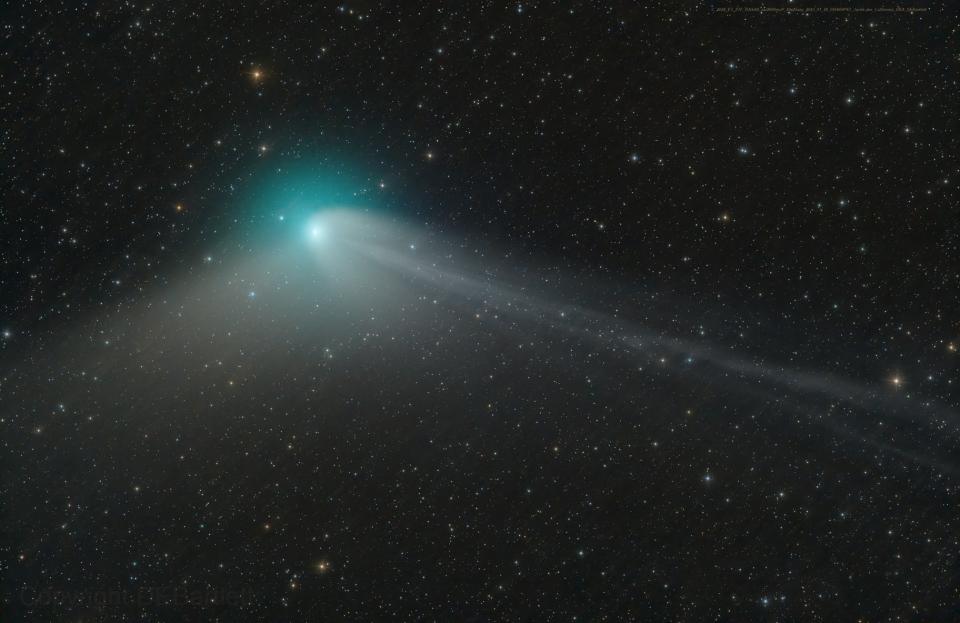
Astronomers, amateurs share photos of green comet as it makes closest approach to Earth
Wednesday 1 February 2023 06:45 , Vishwam Sankaran
Amateur space photographers and astronomers share photos of the green comet on Twitter as it makes close approach to Earth.
Fresh #CometZTF pictures hot off the @yorkobservatory 1m telescope Malincam ccd, even without processing it’s looking great. So glad the clouds parted tonight in #Toronto #C2022E3 #Comet pic.twitter.com/9Ycdaa48BT
— Dr. Hyde (@AstroHyde) February 1, 2023
Comet C/2022 E3 (ZTF) from Central Florida!
This image represents ~25min worth of data. Clouds and the Moon made this a difficult target to acquire.
Stacking & processing took many hours to get right.#Comet #CometE3 #CometZTF #C2022E3 #Astrophotography #Astronomy #Space pic.twitter.com/pBAJSRtZ4A— Ethan Walsh 🍥 (@EthanWalshPhoto) January 31, 2023
Comet C/2022 E3 (ZTF) imaged over 42 minutes this evening using the snazzy #Skywatcher 72ED and my Astro modified #EOS600d , 1 minute exposures, stacked in DSS and tweaked in photoshop #comet #astrophotograohy #sky #stars #C2022E3 #comet #startrails #astro #lookup pic.twitter.com/MeAjunFeX8
— Tim Burgess 🔭🚀 (@TimBurgess) January 30, 2023
How green comet ZTF was discovered
Wednesday 1 February 2023 06:13 , Vishwam Sankaran
The green comet C/2022 E3 (ZTF) was found in March 2022, the discovery largely attributed to astronomers Bryce Bolin and Frank Masci.
While it was initially thought to be an asteroid, the space rock’s condensed coma – its nebulous envelope – indicated it was a comet.
The comet was spotted in a twilight survey by the Caltech-led project the Zwicky Transient Facility.
Comet ZTF over Mount Etna
Image Credit & Copyright: Dario Giannobile pic.twitter.com/2BqXH3DJ4d— Willie Aaron Lewis (@Parsec44) January 28, 2023
For the survey, ZTF uses a special camera to take images nearly every 30 seconds through the Palomar Observatory’s forty-eight-inch telescope.
Researchers have taught machine-learning algorithms to detect moving objects in the sky by analysing these images.
“On March 2nd, all we knew was that we had found a moving object. We reported it to the Minor Planet Center – they are the clearing house for these things,” Tom Prince, one of the lead scientists on the project, told The New Yorker.
Pictures of green comet posted to social media
Wednesday 1 February 2023 06:09 , Graeme Massie
Nasa decodes distinctive shape of green comet
Wednesday 1 February 2023 05:44 , Vishwam Sankaran
The green comet C/2022 E3 (ZTF) hurtling past Earth over the last month has been spotted to have not just one or two tails, but three.
Nasa notes in a blog post that the comet not only has a common dust tail, an ion tail, as well as a green gas coma, but also a rare distinctive anti-tail.
While the dust and ion tails are seen trialing comets, the ZTF’s anti-tail was seen seemingly leading the comet.
This anti-tail, seen in some photographs, is an illusion caused by the Earth moving through the comet’s orbital plane.
“The anti-tail does not actually lead the comet, it is just that the head of the comet is seen superposed on part of the fanned-out and trailing dust tail,” Nasa noted.

ZTF is currently visible all night long from northern latitudes, but is expected to fade from observation during the next few weeks and might never return to pass by Earth.
Some estimates suggest green comet may never again pass by Earth
Wednesday 1 February 2023 05:19 , Vishwam Sankaran
Researchers say the green comet’s current orbit trajectory may see the space rock booted out of the inner Solar System to never return.
“Some predictions suggest that the orbit of this comet is so eccentric it’s no longer in an orbit—so it’s not going to return at all and will just keep going,” astronomer Jessica Lee from the Royal Observatory Greenwich told Newsweek.
While scientists do not yet have an accurate estimate of how far the comet could get from the Earth, they say if it does return, it may not for at least another 50,000 years.
Whether it returns or not may depend on the perturbations the comet may encounter from losing its mass or from any disturbances it might face while in the Oort cloud.
The green comet’s path through the sky
Wednesday 1 February 2023 05:03 , Graeme Massie
Tonight is not the only chance to see the green comet, so don’t lose hope if the weather near you is bad.
This handy map, courtesy of the MISAO Project, shows the path the comet will be taking across the sky over the coming days and weeks.

The early hours of 1 February will see Comet ZTF reach its perigee, meaning it is at its closest point to Earth, but it will still be visible with the naked eye for the next few days in case you don’t get a chance to see it tonight. For a few weeks it will also be possible to see it using binoculars or a telescope.
What we know about Oort cosmic cloud from where green comet originated
Wednesday 1 February 2023 04:53 , Vishwam Sankaran
The green comet C/2022 E3 (ZTF) making its closest pass by Earth today originated from the Oort Cloud, a cosmic shell of debris encircling the farthest reaches of the Solar System.
Scientists have long known that this region, containing billions or trillions of space debris, is the origin site of long-period comets like ZTF.
This region is thought to be a giant spherical shell encircling the Solar System like a thick-walled bubble made of icy rocks.
It is likely at a massive distance of about one-quarter to halfway from the Sun to the next star, according to Nasa.
Scientists have theorised that this region likely formed as gravity from the Solar System’s planets shoved a vast number of icy rocks away from the Sun, and gravity from the galaxy may have caused debris to settle into a border shell.
The comets from this shell can shed light on the history of the Solar System and have been seen only once in recorded history since their orbital periods are very long.
Nasa to study green comet using Webb telescope
Wednesday 1 February 2023 04:30 , Vishwam Sankaran
Nasa is planning to observe the comet with its James Webb Space Telescope to unravel clues about the Solar System.
The comet may shed light on the formation of the Solar System as it likely formed during its early stages, scientists say.
It was first identified by the wide-field survey camera at the Zwicky Transient Facility inside the orbit of Jupiter in March 2022 but was initially suspected to be an asteroid.
“We’re going to be looking for the fingerprints of given molecules that we can’t access from the ground,” planetary scientist Stefanie Milam of NASA’s Goddard Space Flight Center in Maryland said.
“Because JWST’s so sensitive, we’re expecting new discoveries.”
Wednesday 1 February 2023 04:04 , Graeme Massie
What we know about green comet's chemical composition
Wednesday 1 February 2023 03:53 , Vishwam Sankaran
The comet’s green colour is due to the effect of sunlight on its molecules cyanogen and diatomic carbon.
The latter is a green, gaseous chemical with the chemical formula C=C that occurs in the carbon vapour in comets.
These molecules are broken down by sunlight into single carbon atoms before they move into the comet’s tail.
Thus the green colour is limited to the space rock’s icy nucleus while the tail may still appear white in contrast.

 Yahoo News
Yahoo News 
